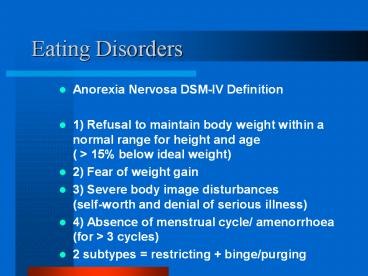Eating Disorders - PowerPoint PPT Presentation
Title:
Eating Disorders
Description:
Eating Disorders Anorexia Nervosa DSM-IV Definition 1) Refusal to maintain body weight within a normal range for height and age ( 15% below ideal ... – PowerPoint PPT presentation
Number of Views:157
Avg rating:3.0/5.0
Title: Eating Disorders
1
Eating Disorders
- Anorexia Nervosa DSM-IV Definition
- 1) Refusal to maintain body weight within a
normal range for height and age
( gt 15 below ideal weight) - 2) Fear of weight gain
- 3) Severe body image disturbances
(self-worth and denial of serious illness) - 4) Absence of menstrual cycle/ amenorrhoea (for
gt 3 cycles) - 2 subtypes restricting binge/purging
2
Eating Disorders
- Bulimia Nervosa DSM-IV Definition
- 1) Episodes of binge eating (loss of control)
- 2) Followed by compensatory behaviour of
- Purging type (vomiting, laxatives, diuretics)
- Non-purging (execise, fasting, diets)
- 3) Occurring gt 2x / week for 3/12
- 4) Dissatisfaction with body shape / weight
3
Epidemiology
- 1-2 million BN in USA
- 1/2 million AN in USA
- AN prevalence overall 0.27
- AN prevalence in 15-19y 0.48
- BN prevalence overall 1.5
- BN is more common in the gt18y
- Women 101 Men
- Many more have ED-NOS ( eating disorder not
otherwise specified
4
Pathogenesis
- Social pressure
- Female athelete triad (eating disorder,
amenorrhoea, and osteoprosis) - Related to a combination of psychological,
biological, family, genetic, environmental and
social factors. - Decreased self esteem or self control then using
dieting behaviour and weight loss as a way of
providing stability/ control on life. - Genetics Monozygotic twins and 1st degree
relatives have higher rates of eating disorders,
Xolism, affective disorders
5
Pathogenesis
- Sexual abuse - no evidence
- Family characteristics high parental
expectations, difficulty managing conflict, poor
communication skills, enmeshment, estrangement,
devaluation of maternal role and maritial
tensions. - CNS / Hormonal
- Nad bradycardia and hypotension in starvation
- Serotonin high in AN, affects the appetite and
satiety centres
6
Screening
- SCOFF Score gt2
- Sick
- Control ( or rather loss of it )
- One stone in lt 3/12
- Fat
- Food dominates life
7
Examination
- Vital signs ( PR and BP)
- Lanugo hair
- Callous formation
- Parotid gland hypertrophy
- Erosion of dental enamel on anterior teeth
- CVS ( bradycardia, arrhythmias, MVP )
- GI
- Neuro
8
Investigations
- FBC (anaemia)
- Ur Cr (dehydration)
- Electrolytes K, Ca, Mg, PO4
- B- HCG
- TFTs
- Prolactin (prolactinoma)
- FSH
9
Complications
- Osteoporosis
- Cardiac impairment
- Psychiatric Cognitive Changes
- Infertility
- GI Dysfunction ( slow motility, N, bloating)
- Electrolytes ( K, metabolic alkalosis )
- Endocrine
- low LH and FSH
- Sick euthyroid ( high rT3 )
- low DHEA IGF-1
- high cortisol GH
10
Osteopenia / Osteoporosis
- Women accrue 40-60 of their bone mass during the
adolescent years - Seen in 90 of those with AN
- Long term risk of fracture increases x 3
- Causes - oestogen deficiency
- - inadequate Vitamin D and Ca
- - Lean body mass and nutritional
- Pathophysiology - increased bone resorption
- - decreased bone
formation - (differing from
meopause)
11
Osteopenia / Osteoporosis Rx
- Ix with DEXA then
- 1) Weight gain
- 2) Elemental Ca 1200 - 1500 mg/ day
- 3) Multivitamins providing 400 IU Vit D / day
- 4) Oestrogen/ Progestin
- no proven benefit as process is different to
menopause - some benefit if lt 70 ideal body weight
- 5) IGF-1 (short term effects)
- 6) DHEA
- increases formation and decreases resorption in
the short term
12
Cardiac Mx
- MVP occurs in 30 - 60 (3Xpopulation)
- this is partly due to enhanced ability to detect
MVP in patients with intravascular volume
depletion - Prolonged QT interval seen in 33
- independent marker for arrhythmias and sudden
death - Heart Failure in the first 2/52 of Re-feeding
- Reduced cardiac contractility
- Refeeding oedema
- Mx by slow refeeding, repletion of PO4, avoid
high Na
13
Amenorrhoea
- Seen in 90 of AN
- Low levels of LH FSH low Oestrogen
- Mx Increase weight
- Menses restarts in 90 in lt 6/12 after achieving
90 ideal body weight
14
Multidisciplinary Mx
- a) Medical Provider
- Vital signs
- Fluoxetine (proven benefits in BNgtAN)
- Anxiolytics in AN prior to eating
- Metoclopramide (delayed transit bloating
constip) - b) Mental Health Provider
- Individual and cognitive behavioral therapy
- superior to medication, but synergistic with it
- c) Nutritionalist
- Specific and meal plan requirements
- Weight goals
15
Hospitalisation
- Severe malnutrition (lt75 IBW)
- Dehydration
- Electrolyte Disturbance
- Cardiac Dysrythmias
- Physiological AbNs (eg brady, hypotensive)
- Arrested Growth and Development
- Failure of Outpatient treatment
- Complications (medical of psychiatrical)
- Admission long enough to increase weight gt90 IBW
improves eventual outcome
16
Management
- Nutritonal
- IP Expected weight gain 0.9-1.4 kg/week
- OP Expected weight gain 0.2-0.5 kg/week
- Start intake at 30-40 kcal/day (1000-1600kcal/day)
- Rapid early weight gain is related to fluid
retention and to low metabolic rate - Refeed Syndrome
- At risk are those gt 10 beneath their ideal body
weight - Hypophosphataemia
- Decreased IC ATP impaired enegy stores
- Decreased rbc 2,3-DPG tissue hypoxia
17
Outcome
- AN
- 50 good outcome
- 25 intermediate ( with relapses)
- 25 poor ( associated with later age of onset,
duration, lower minimum weight, strong maturity
fears ) - 30 - 70 fully recovered at 20y follow up
- 10 continue to meet criteria for AN at 12y
- BN
- 30 continue to meet criteria for BN at 10y
- Low self esteem associated with a poor outcome
- Dehydration
- Mortality Rate in AN 6.6
- 54 complications, 27 suicide, 19 others































